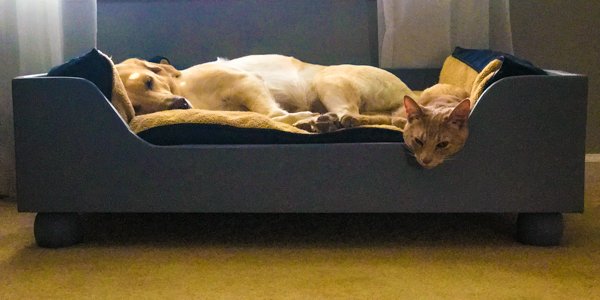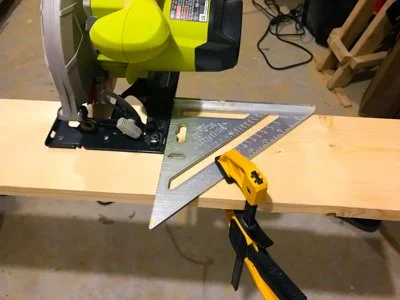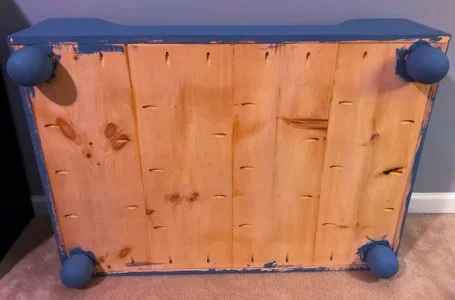Raised Dog Bed Build: A Cozy Upgrade
Updated: April 2024
This raised dog bed was my first project after we moved into our house. I did not think through pictures or a post then, so please forgive the lack of photos and detail. I also used this as a chance to test solid wood vs. plywood.
The Problem to Solve
Our carpet smells when the dog bed is directly on it. We also wanted to coordinate the bed better with the room.
Affiliate links are used on this page. See my disclosure page for info on affiliate programs.
Tools
* These were the tools I used then, but I recommend better ones now.
Materials
3/4” Plywood
1x6 Square Edge Pine
Fence Post Cappers
2” Deck Screws
1 - Measure the existing dog bed
To solve our problems, the bed needed to meet four main criteria:
Be raised off the ground
The color should coordinate with the room
Dimensions must accommodate the existing bed
Hold the weight of our lab plus a cat or two
Fortunately, the raised factor and color would take care of themselves in the preliminary design phase. Accommodating the existing bed was as simple as measuring it. This is where the dip in the middle originated. We made sure to measure not only the basic width and depth but also the height of the main bed and taller pillows to gauge the rough dip dimensions. Choosing to use 3/4″ material solved the problem of holding the weight.
The interior width needed was 22″. I did not have the tools to rip material to width at the time. 1×6 boards were the perfect candidate to give me the width without requiring rip cuts.
2 - Cut material to size
The bottom panel came first. The design had a frame surrounding it, identical to the basic dimensions of the existing dog bed. Since no rip cuts were needed, I used my circular saw to cut the 1×6 material to length.
I used a speed square to keep each cut square. After I measured the first piece, I used it to measure the following three cuts to ensure they would all be close to identical.
Once I cut the bottom four pieces, they were dry-fit and measured for the front and back dimensions. The front and back were both 1×6 as well, so the same circular saw and speed square technique was used.
I cut the sides out of plywood. Then, I clamped a scrap piece of wood to use as a fence to rip the plywood to size before cutting both pieces to length.
For the front dip, I marked the height and width of the short part of the bed. These marks gave me a rough area to cut out. Instead of square cuts, I added gentle curves to both sides. With everything marked out, I used my jigsaw to cut it out.
With all the cuts made, I sanded everything with a random orbit sander up to 220 grit.
3 - Drill pocket holes
For the project, I wanted to hide screws as much as possible. I used pocket holes and glue since it was my first big project.
I started with the bottom panel. For this, I wanted to have pocket holes on both sides of the joined panel boards and along the perimeter to secure the panel to the frame.
I designed the frame so the front and back boards span the whole width and the sides butt up against them. I used pocket holes to attach the side frame pieces. These will ultimately go inside the frame where the pillow will hide them.
4 - Assembly
Assembly was easy once everything I laid everything out. I started with the bottom panel and dry-fit everything together. On the inside edges, I added glue before screwing it together with pocket hole screws and my Impact Driver.
With the panel complete, I moved on to the frame. Again, using glue and pocket hole screws, I attached one short side to the backboard. I made sure the bottom pocket holes were facing down and glued/screwed the bottom panel to the two frame pieces.
I assembled the other side piece and the front next.
At this point, I did not like the bottom part of the fence post toppers. I clamped each one and used the jigsaw with a longer blade to cut the bottoms off and leave only the round top. Fortunately, this left a flat surface to secure the rest of the bed.
I marked the location of the feet on the inside of the bottom panel, then drilled and countersunk pilot holes for three screws into each. I glued the feet and screwed them into place with the 2″ screws.
5 - Apply finish
For the main finish, we used leftover paint from our bedroom’s accent wall. I applied two coats to the inside and outside of the frame and the feet. The bed would cover the bottom panel, so we didn’t waste the paint there.
Fortunately, we purchased high-quality plywood. In hindsight, it would have looked better if we had sealed the plywood edges with spackle or edge banding. It turned out all right for our purposes with a second coat of paint, but it would have been easier in the future.
Our dog (and cats) love this bed. We’re unsure why, but it gets more use now than without the frame. If I were to make another one now, I would make the bottom panel out of plywood and the sides out of lumber. I would also miter the corners on all sides so there were no exposed edges.
Since this was my first project, I was thrilled with how it looked. Our dog and cats have also been happily using it since I completed it.




